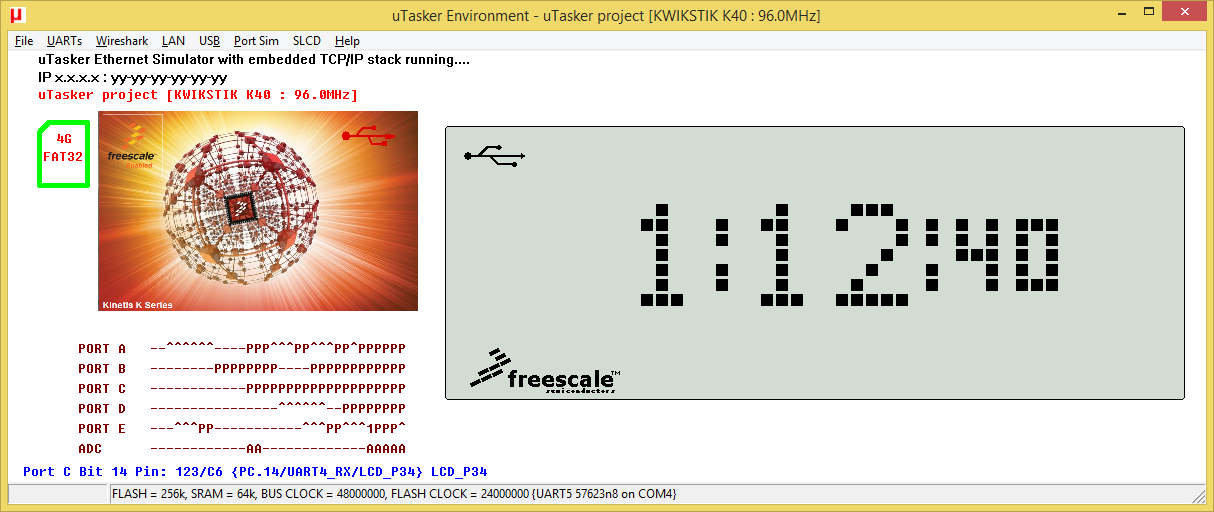KWIKSTIK

The KWIKSTIK is based on the K40X256VLQ100 which is a 100MHz device from the performance and integration K40 family with Cortex-M4 core, USB and SLCD (segment LCD). This K40 device has 256k Flash (plus 256k FlexNMV) and 64k SRAM and is in a 144 pin LQFP, whereby it is also available in 80, 100 and 121 pin packages. There is an 8MHz crystal on the board for clocking the part.
Full details and documentation for this board can be obtained from the Freescale web site: KWIKSTIK
To configure the µTasker project for this board simply enable the define KWIKSTIK in the project's config.h file. The compiler needs to be set to build for Cortex M4 (and not Cortex M0+) and the linker script K_256_64.ld should be selected [K_256_64_BM.ld for downloadable version] {the linker script extension may vary for different compilers, whereby *.ld is valid for GCC}
KWIKSTIK Binaries
Here are some binary files that can be loaded to the board. These were built using the µTasker applications (serial loader and V1.4 application) and can be simply generated using the supported compilers/IDEs [these were built using GCC], built using different configuration options or modified to suit specific requirements or hardware derived from this board:
-
uTaskerSerialBoot_KWIKSTIK_KBOOT_HID_MSD.bin KBOOT compatible USB-HID loader with composite USB-MSD loading [14.3k] allowing applications to be loaded at link address 0x8080 (using Freescale's KBOOT USB connection or USB-MSD when the board appears as upload hard disk or as a file on the SD card).
When operating, the Freescale logo in the SLCD flashes at 5Hz. To force the loader, reset the board with pins 1-3 of J15 shorted together. To disable the watchdog, reset the board with pins 2-4 of J15 shorted together.
This can be loaded using CodeWarrior's Flash utility via the KWIKSTIK's inbuld Jlink debug interface. Note that the loader limits application sizes to 70k - it can be built without limits using the µTasker project. -
uTaskerV1.4.8_BM_KWIKSTIK_8080.bin KWIKSTIK application with the time displayed in the SLCD and a composite USB device with USB-CDC and USB-MSD. When connected via USB-CDC a command line menu (shell) is available including various functions that can be executed. The USB-MSD interface appears as a hard drive to the PC and uses the 256k internal FlexNVM in data mode as a flash disk. Files can then be read and written to the drive from the PC and also worked with via the DOS-like command line interface in the disk-interface sub-menu.
The flash drive can be formatted by a PC host when connected via USB and is seen as a 256k disk. Usually it will format it as FAT12 which gives a usable space of 236k due to the FAT12 overhead.
Linked to 0x8080, this binary image can be loaded with drag-and-drop onto the upload disk that appears when the serial loader is operating or using the KBOOT loader's USB connection. When the application is running, the Freescale logo in the SLCD blinks at 2.5Hz.
The processor runs at 96MHz to allow USB operation [57.3k]. - uTaskerV1.4.8_KWIKSTIK.bin The same KWIKSTIK application as stand-alone software that can be loaded using CodeWarrior's Flash utility via the KWIKSTIK's Jlink debug interface [58.3k]. Due to the USB-CDC operation, a USB driver is required - these are linked below.
- uTaskerFreescaleMultiVirtualCOMx1.inf USB composite CDC/MSD installation file for 32-bit windows.
- uTaskerFreescaleMultiVirtualCOMx1_64bit.inf USB composite CDC/MSD installation file for 64-bit windows. See the following for a guide to installing unsigned drivers on Windows 8.1
- uTaskerV1.4.8_KWIKSTIK.zip Simulation executable for this configuration - this requires no installation and can be started by extracting and simply executing the file uTaskerV1.4.8_KWIKSTIK.exe.
SD Card Operation
The following binary can be used on V5 revision boards (V3 and V4 have SD card socket wiring errors). It includes utFAT and allows the SD card to be worked with (SDCARD_SUPPORT) - the command line interface on the USB-CDC connection includes as DOS-like disk interface allowing standard, as well as advanced analysis operations to be performed:
Disk interface =================== up go to main menu info utFAT/card info dir [path] show directory content dird [path] show deleted directory content dirh [path] show hidden content infof [path] show file info infod [path] show deleted info cd [path] change dir. (.. for up) file [path] new empty file write [path] test write to file mkdir new empty dir rename [from] [to] rename trunc truncate to [length] [path] hide [path] file/dir to hide unhide [path] file/dir to un-hide prot [path] file/dir to write-protect unprot [path] file/dir to un-protect print [path] print file content del [path] delete file or dir. undel undelete [name] format [-16/12] [label] format (unformatted) disk fformat [-16/12] [label] full format (unformatted) disk re-format [-16/12] [label] reformat disk!!!!! re-fformat [-16/12] [label] full reformat disk!!!!! sect [hex no.] display sector help Display menu specific help quit Leave command mode
The processor runs at 96MHz to allow USB operation [48.9k].
Return to the Kinetis landing page
µTasker Kinetis KWIKSTIK support. Copyright (c) 2004..2018 M.J.Butcher Consulting